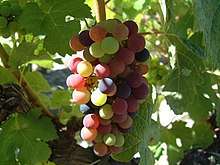Ripening
Ripening is a process in fruits that causes them to become more palatable. In general, fruit becomes sweeter, less green (typically "redder"), and softer as it ripens. Even though the acidity of fruit increases as it ripens, the higher acidity level does not make the fruit seem tarter. This effect is attributed to the Brix-Acid Ratio.[1] Underripe fruits are also fibrous, less juicy, and have tougher outer flesh than ripe fruits.
.3.jpg)

Science of ripening
Early in the ripening process, fruit synthesizes compounds, including alkaloids and tannins.These compounds, which are antifeedants, fight infections and cause underripe fruit to taste bitter and astringent. These adaptations are an essential tool for the plants to ward off eager eaters who might take the fruit and the undeveloped seeds before they're ready. [2]

Ripening agents
Ripening agents accelerate ripening. An important ripening agent is ethylene, a gaseous hormone produced by many plants. Many synthetic analogues of ethylene are available They allow many fruits to be picked prior to full ripening, which is useful since ripened fruits do not ship well. For example, bananas are picked when green and artificially ripened after shipment by being explosed to ethylene.
Calcium carbide is also used in some countries for artificially ripening fruit. When calcium carbide comes in contact with moisture, it produces acetylene gas, which is similar in its effects to the natural ripening agent, ethylene. Acetylene accelerates the ripening process. Catalytic generators are used to produce ethylene gas simply and safely. Ethylene sensors can be used to precisely control the amount of gas. Covered fruit ripening bowls or bags are commercially available. These containers increase the amount of ethylene and carbon dioxide gases around the fruit, which promotes ripening.[4]
Climacteric fruits continue ripening after being picked, a process accelerated by ethylene gas. Non-climacteric fruits can ripen only on the plant and thus have a short shelf life if harvested when they are ripe.
Ripening indicators
Iodine (I) can be used to determine whether fruits are ripening or rotting by showing whether the starch in the fruit has turned into sugar. For example, a drop of iodine on a slightly rotten part (not the skin) of an apple will stay yellow or orange, since starch is no longer present. If the iodine is applied and takes 2–3 seconds to turn dark blue or black, then the process of ripening has begun but is not yet complete. If the iodine becomes black immediately, then most of the starch is still present at high concentrations in the sample, and hence the fruit hasn't fully started to ripen.
Ripening stages
Climacteric fruits undergo a number of changes during fruit ripening. The major changes include fruit softening, sweetening, decreased bitterness, and colour change. These changes begin in an inner part of the fruit, the locule, which is the gel-like tissue surrounding the seeds. Ripening-related changes initiate in this region once seeds are viable enough for the process to continue, at which point ripening-related changes occur in the next successive tissue of the fruit called the pericarp.[5] As this ripening process occurs, working its way from the inside towards outer most tissue of the fruit, the observable changes of softening tissue, and changes in color and carotenoid content occur. Specifically, this process activates ethylene production and the expression of ethylene-response genes affiliated with the phenotypic changes seen during ripening.[6] Colour change is the result of pigments, which were always present in the fruit, becoming visible when chlorophyll is degraded.[7] However, additional pigments are also produced by the fruit as it ripens.[8]
In fruit, the cell walls are mainly composed of polysaccharides including pectin. During ripening, a lot of the pectin is converted from a water-insoluble form to a soluble one by certain degrading enzymes.[9] These enzymes include polygalacturonase.[7] This means that the fruit will become less firm as the structure of the fruit is degraded.
Enzymatic breakdown and hydrolysis of storage polysaccharides occurs during ripening.[7] The main storage polysaccharides include starch.[7] These are broken down into shorter, water-soluble molecules such as fructose, glucose and sucrose.[10] During fruit ripening, gluconeogenesis also increases.[7]
Acids are broken down in ripening fruits[10] and this contributes to the sweeter rather than sharp tastes associated with unripe fruits. In some fruits such as guava, there is a steady decrease in vitamin C as the fruit ripens.[11] This is mainly as a result of the general decrease in acid content that occurs when a fruit ripens.[7]
Different fruit have different ripening stages. In tomatoes the ripening stages are:
- Green: When the surface of the tomato is completely green
- Breaker: When less than 10% of the surface is red
- Turning: When less than 30% of the surface is red (but not less than 10%)
- Pink: When less than 60% of the surface is red (but not less than 30%)
- Light Red: When less than 90% of the surface is red (but not less than 60%)
- Red: When the surface is nearly completely red.[12]
List of climacteric and non-climacteric fruits
This is an incomplete list of fruits that ripen after picking (climacteric) and those that do not (non-climacteric).
Climacteric
Non-climacteric
Ripening regulation
There are two patterns of fruit ripening: climacteric that is induced by ethylene and non-climacteric that occurs independently of ethylene.[14] This distinction can be useful in determining the ripening processes of various fruits, since climacteric fruits continue ripening after they are removed due to the presence of ethylene, while nonclimacteric fruits only ripen while still attached to the plant. In non-climacteric fruits, auxins act to inhibit ripening. They do this by repressing genes involved in cell modification and anthocyanin synthesis.[15] Ripening can be induced by abscisic acid, specifically the process of sucrose accumulation as well as color acquisition and firmness.[16] While ethylene plays a major role in the ripening of climacteric plants, it still has effects in non-climacteric species as well. In strawberries, it was shown to stimulate color and softening processes. Studies found that the addition of exogenous ethylene induces secondary ripening processes in strawberries, stimulating respiration.[17] They suggested that this process involves ethylene receptors that may vary between climacteric and non-climacteric fruits.
Methyl jasmonate
Jasmonate is involved in multiple aspects of the ripening process in non-climacteric fruits. This class of hormones includes jasmonic acid and methyl jasmonate. Studies showed that the expression of genes involved in various pathways in ripening was increased with the addition of methyl jasmonate.[14] This study found that methyl jasmonate led to an increase in red coloration and the accumulation of lignin and anthocyanins, which can be used as ripening indicators. The genes they analyzed include those involved in anthocyanin accumulation, cell wall modification, and ethylene synthesis; all of which promote fruit ripening.[14]
Abscisic acid
ABA also plays an important role in the ripening of non-climacteric plants. It has been shown to increase the rate of ethylene production and anthocyanin concentrations.[16] Ripening was enhanced, as seen with the accelerated fruit coloration and softening. This occurs because ABA acts as a regulator of ethylene production, increasing synthesis similarly to climacteric fruits.[16]
See also
- Bletting, a post-ripening reaction that some fruits undergo before they are edible
References
- Kimball, Dan (1991). The Brix/Acid Ratio. Citrus Processing. pp. 55–65. doi:10.1007/978-94-011-3700-3_4. ISBN 978-94-010-5645-8.
- Lunawat, Dev (2019-05-06). "Why do bananas go bad so fast?". Science ABC. Retrieved 2019-12-03.
- Blankenship, Sylvia M; Dole, John M (April 2003). "1-Methylcyclopropene: a review". Postharvest Biology and Technology. 28 (1): 1–25. doi:10.1016/S0925-5214(02)00246-6.
- "How to Ripen Fruit Faster". 2013-09-20.
- Shinozaki, Y.; et al. (2018). "High Resolution spatiotemporal transcriptome mapping of tomato fruit development and ripening". Nature Communications. 9 (1): 364. doi:10.1038/s41467-017-02782-9. PMC 5785480. PMID 29371663.
- Van de Poel, Bram; et al. (2014). "Tissue specific analysis reveals a differential organization and regulation of both ethylene biosynthesis and E8 during climacteric ripening of tomato". BMC Plant Biology. 14: 11. doi:10.1186/1471-2229-14-11. PMC 3900696. PMID 24401128.
- Prasanna, V.; Prabha, T.N.; Tharanathan, R.N. (2007). "Fruit ripening phenomena-an overview". Critical Reviews in Food Science and Nutrition. 47 (1): 1–19. doi:10.1080/10408390600976841. PMID 17364693.
- Atwell, Brian J.; Kriedemann, Paul E.; Turnbull, Colin G.N., eds. (1999). "11.5.5 Colour and flavour". Plants in Action: Adaptation in Nature, Performance in Cultivation. Macmillan Education Australia. ISBN 978-0732944391.
- Xuewu Duana; Guiping Chenga; En Yanga; Chun Yia; Neungnapa Ruenroengklina; Wangjin Lub; Yunbo Luoc; Yueming Jiang (November 2008). "Modification of pectin polysaccharides during ripening of postharvest banana fruit". Food Chemistry. 111 (1): 144–9. doi:10.1016/j.foodchem.2008.03.049.
- Medlicott, A.P.; Thompson, A.K. (1985). "Analysis of sugars and organic acids in ripening mango fruits (Mangifera indica L. var Keitt) by high performance liquid chromatography". J. Sci. Food Agric. 36 (7): 561–6. doi:10.1002/jsfa.2740360707.
- Bashir, H.A.; Abu-Goukh, A.A. (2003). "Compositional changes during guava fruit ripening". Food Chemistry. 80 (4): 557–563. doi:10.1016/j.foodchem.2008.03.049.
- "Guide to ripening stages" (PDF). Lagorio family companies.
- Theologis, A. (1992). "One Rotten Apple Spoils the Whole Bushel: The Role of Ethylene in Fruit Ripening". Cell. 70 (2): 181–184. doi:10.1016/0092-8674(92)90093-R. PMID 1638627.
- Concha, Cristóbal M.; Figueroa, Nicolás E.; Poblete, Leticia A.; Oñate, Felipe A.; Schwab, Wilfried; Figueroa, Carlos R. (2013-09-01). "Methyl jasmonate treatment induces changes in fruit ripening by modifying the expression of several ripening genes in Fragaria chiloensis fruit". Plant Physiology and Biochemistry. 70: 433–444. doi:10.1016/j.plaphy.2013.06.008. ISSN 0981-9428.
- Aharoni, Asaph; Keizer, Leopold C. P.; Broeck, Hetty C. Van Den; Blanco-Portales, Rosario; Muñoz-Blanco, Juan; Bois, Gregory; Smit, Patrick; Vos, Ric C. H. De; O'Connell, Ann P. (2002-07-01). "Novel Insight into Vascular, Stress, and Auxin-Dependent and -Independent Gene Expression Programs in Strawberry, a Non-Climacteric Fruit". Plant Physiology. 129 (3): 1019–1031. doi:10.1104/pp.003558. ISSN 0032-0889. PMC 166497. PMID 12114557.
- Jiang, Yueming; Joyce, Daryl C. (2003-02-01). "ABA effects on ethylene production, PAL activity, anthocyanin and phenolic contents of strawberry fruit". Plant Growth Regulation. 39 (2): 171–174. doi:10.1023/A:1022539901044. ISSN 0167-6903.
- Tian, M. S.; Prakash, S.; Elgar, H. J.; Young, H.; Burmeister, D. M.; Ross, G. S. (2000-09-01). "Responses of strawberry fruit to 1-Methylcyclopropene (1-MCP) and ethylene". Plant Growth Regulation. 32 (1): 83–90. doi:10.1023/A:1006409719333. ISSN 0167-6903.
External links
- Koning, Ross E. (1994). "Fruit Ripening". Plant Physiology Information Website. Archived from the original on 2007-09-27.CS1 maint: BOT: original-url status unknown (link)
- Oetiker, J.H.; Yang, S.F. (1995). "The role of ethylene in fruit ripening". Acta Horticulturae. 398 (398): 167–178. doi:10.17660/ActaHortic.1995.398.17.
- Burg SP, Burg EA (March 1962). "Role of Ethylene in Fruit Ripening". Plant Physiol. 37 (2): 179–89. doi:10.1104/pp.37.2.179. PMC 549760. PMID 16655629.
- Chu, Michael. "Fruit Ripening: Fruits which ripen after harvest". Cooking For Engineers.